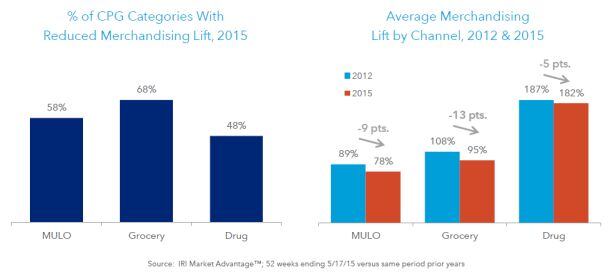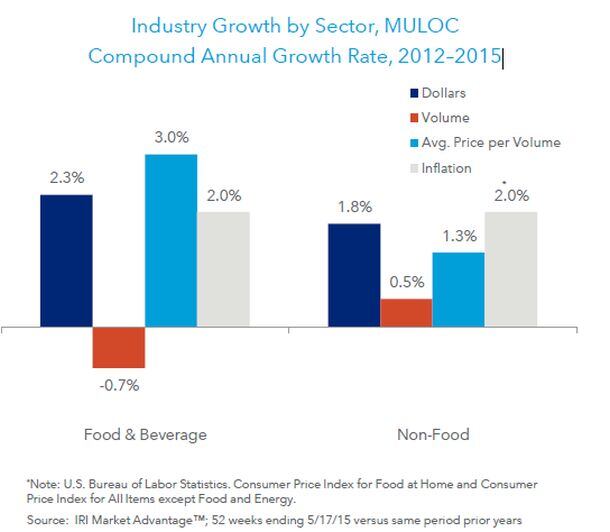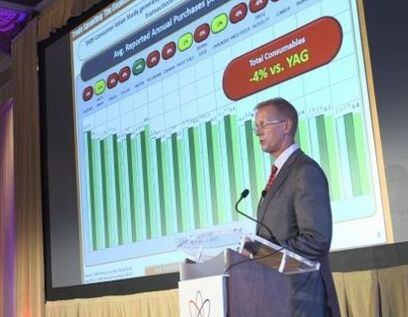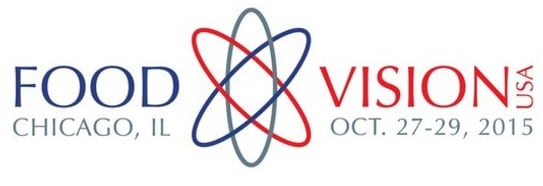“During the past year, merchandising lift fell across 58% of CPG categories, including 72 of the 100 largest categories," says the IRI Times & Trends report, Merchandising for Growth: "This trend is cutting across the store, with many categories seeing double-digit losses in sales lift while investment in merchandising continues to escalate.
“Erosion has been occurring for years, yet merchandising activity is up across 40% of CPG categories accounting for 39% of dollar sales, and promotional programs are recycled year after year.”
Yet the more cash desperate CPG brands are pumping into trade spending, the less impact they seem to be having, claims IRI, which says that the grocery channel experienced “more widespread declines versus the industry as a whole during the past year, with 68% of categories seeing average lift fall."
It adds: "The CPG industry is in trouble, and the time for change is now.”
Trade spending is a huge pain point for retailers and manufacturers
But why are they getting such a lousy bang for their promotional bucks, and what should they do about it?
The answer to the first question is harder to answer than the second, as multiple factors are at play including changing consumer attitudes, a loss of brand equity for some the biggest grocery brands, and poorly planned and executed promotions that are not delivering for consumers, retailers or manufacturers alike, Susan Viamari, VP, thought leadership at IRI, told FoodNavigator-USA.
“It’s definitely a huge pain point for retailers and manufacturers right now.”

There’s still this kind of throw it against the wall and see what sticks mentality
As to what they can do about it, CPG marketers who “rewire their price pack architecture to deliver surgically executed competitive pricing strategies” can succeed in a slow-growth environment, she argued.
But this requires a shift in thinking to a collaborative promotional planning model that is strategic, rather than purely tactical, and tailored to the mindset of shoppers in different channels or banners, she said.
“So in a club store you might be thinking about price per serving, whereas in a dollar store you’re looking at the unit price. But there’s still this kind of throw it against the wall and see what sticks mentality.”
“In packaged goods aisles, sales and promotional activity abounds. More than one-quarter of volume, on average, was sold with merchandising support during the past year, accounting for 39% of dollar sales
The reality is, packaged goods marketers are investing heavily in promotional efforts, in the hopes of spurring brand, category, and industry growth. Unfortunately, the results of those efforts are not what marketers had hoped: volume is flat to negative nearly across the board.” IRI Times & Trends: Merchandising for Growth, Nov 2015
‘There’s too much recycling going on of deal strategies that weren’t effective then and won’t be effective now.’

Manufacturers also need to analyze their portfolios from a promotional price elasticity perspective as well she said. Where elasticity is high, for example, it makes more sense to allocate spending to trade efforts, whereas in other categories or with certain brands, you may just be needlessly giving away margin, she added.
“This means investing to understand not just products to be merchandised, but also depth, frequency and timing, and the interplay of those factors on merchandising lift.”
The problem is that there is still too much recycling going on of deal strategies that “weren’t effective then and won’t be effective now”, she claimed, adding that manufacturers need to develop a more nuanced strategy that might involve more channel- or customer-specific activities rather than a one-size fits-all approach.
Promotions have long played a key role in informing and influencing CPG shoppers. Today, 45% of consumers will stock up on certain items when they are on sale and 28% of consumers will buy a brand other than their preferred brand when it is on sale.” IRI Times & Trends: Merchandising for Growth, Nov 2015
TABS Group: Time to seize back the initiative…

Her comments were echoed by Dr. Kurt Jetta, founder & CEO of CPG analytics firm TABS Group, who told delegates at Food Vision USA in Chicago last month that many CPG companies are simply not properly tracking and evaluating their trade spending, which means they are not learning from it.
Promotions can and do deliver incremental growth, but manufacturers have to stop writing off trade spending as a 'cost of doing business', and instead seize back the initiative, and come up with an evidence-based strategy that creates win-wins for all parties (manufacturers, retailers, consumers), he said.
Despite the excitement over the brave new world of online coupons and personalized promotions, meanwhile, “old school” strategies from Sunday circulars to FSIs (free standing inserts) still do better, he told us during a break in proceedings.
* IRI Times & Trends: Merchandising for Growth, November 2015

Food Vision USA was sponsored by the Welsh Government, Gelita, Ganeden and Kerry.
